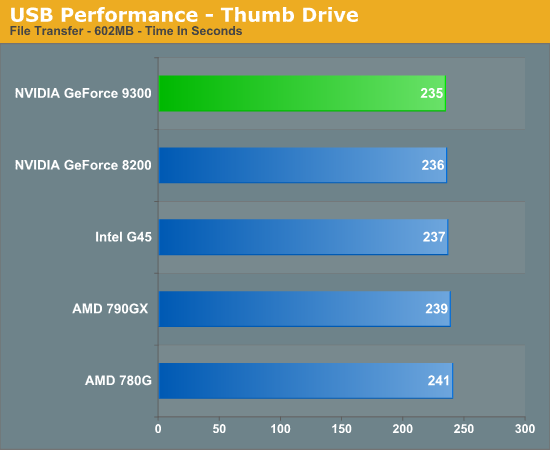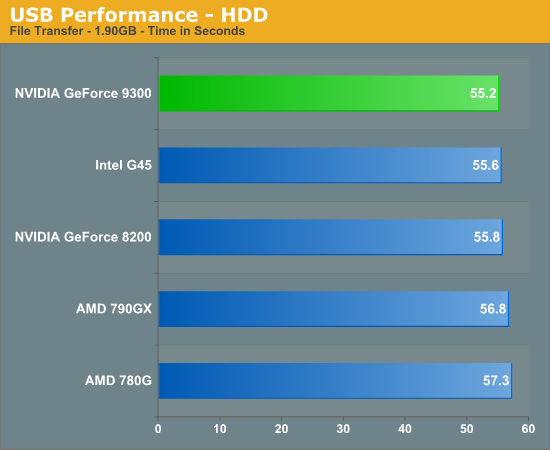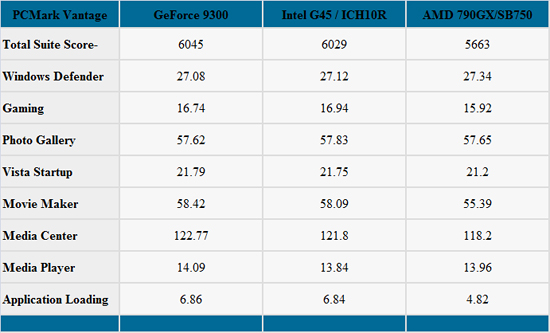The IGP Chronicles Part 3: NVIDIA's GeForce 9300
by Anand Lal Shimpi & Gary Key on October 15, 2008 12:00 AM EST- Posted in
- Motherboards
USB, Networking and Storage Performance
Our USB transfer speed tests were conducted with an OCZ Rally 2 Turbo 4GB Flash Drive and USB 2.0/FireWire based Maxtor OneTouch II external hard drive. In our first test, we transfer a 602MB file folder containing 444 files of various sizes. In our second test, we transfer a 1.90GB file folder containing 17 different files.
USB Performance


NVIDIA chipsets have always performed well in our USB tests and once again hold a slight edge over the Intel and AMD offerings. The improved USB performance from the AMD SB700/750 Southbridges almost close the gap with the NVIDIA and Intel offerings.
Ethernet Performance
The current motherboard test suite includes LAN performance measurements. All of these boards utilize PCI or PCI Express based Gigabit controllers with the only difference being the supplier of the core logic. The Windows 2000 Driver Development Kit (DDK) includes a useful LAN testing utility called NTttcp. We used the NTttcp tool to test Ethernet throughput and the CPU utilization of the various Ethernet Controllers used on the Intel motherboards.
We set up one machine as the server; in this test, an Intel system with an Intel CSA Gigabit LAN connection. Intel CSA has a reputation for providing fast throughput and is a logical choice for our Gigabit LAN server.
On the server side, we used the following Command Line as suggested by the VIA whitepaper on LAN testing:
Ntttcpr -m 4,0,‹server IP› -a 4 -l 256000 -n 30000
On the client side (the motherboard under test), we used the following Command Line:
Ntttcps -m 4,0,‹client IP› -a 4 -l 256000 -n 30000
At the conclusion of the test, we captured the throughput and CPU utilization figures from the client screen.


Our network throughput test indicates how well a particular controller design from Realtek, Marvell, NVIDIA, or Intel performs instead of being indicative of true chipset performance. This also holds true for the CPU utilization results, though this test can also be influenced to certain degree by the BIOS code and chipset interconnect design.
PCMark Vantage
PCMark Vantage is the latest benchmark available from Futuremark, and it is only for use with Windows Vista. Similar to the venerable PCMark05 in its makeup, Vantage modernizes the criteria and test methodology to reflect what users may encounter when running the new Windows OS and current applications. The total benchmark is roughly 87% reads and 13% writes in nature. We run each test five times per drive, producing a median score that we use for comparison in our charts. We utilize AHCI settings for each board.

NVIDIA chipsets generally provide excellent performance, albeit at the cost of stability at times, and our tests reveal a controller that is slightly better in performance than the Intel ICH10R. Really, it is a toss-up between the two controllers. The AMD SB750 trails slightly due to an AHCI implementation that is not as robust as the current NVIDIA or Intel offerings. However, it would be very difficult to discern any performance differences between these controllers in actual application work.
As we noted earlier, we had a few issues with AHCI settings and our Sony BDU-X10S BD drive along with some random slowdowns when transferring large amounts of data (Update- Latest BIOS/Firmware/Drives solved this problem). We have not and do not expect to notice any data corruption problems that crept up during the 780i/790i launch, which were eventually fixed by NVIDIA. Our Intel G45 board also had difficulties with the same Sony BD drive but the AMD SB700/750 have not been affected.










47 Comments
View All Comments
Badkarma - Wednesday, October 15, 2008 - link
Why would it be impossible to stream media? Most media streams are only a fraction of 100Mbit ethernet, even a full Blu-ray disc rarely hits 20+Mbit. The CPU usage charts for network traffic in this review are for full thoroughput tests, the NIC will never come close to pushing that much traffic when streaming media.Zstream - Wednesday, October 15, 2008 - link
I stream 300mbs/sec all the time on my HTPC with my gig Intel nic. I guess you never streamed across multiple devices. It is called VOD, if you do not believe me look at the newest tivo.R3MF - Wednesday, October 15, 2008 - link
Is this the chipset that nvidia is supposed to have worked with Via on to ensure Nano support?A HP mininote v2 using Nano and this mGPU would be an awesome product that would take a dump on every other netbook from a great height!
Hlafordlaes - Wednesday, October 15, 2008 - link
That's my understanding, too. I was wondering what the delay was caused by, now my guess is that Apple wanted the exclusive for launch. Let's hope some new mini-ITX 2.0 Nano boards with this chipset will appear soon.R3MF - Wednesday, October 15, 2008 - link
A lot of netbook newsites are reporting drastic price cuts in the mininote 2133, which is fueling speculation that a v2 may be due out soon.As it happens; there is already a petition requesting HP use the Nano + MCP79 combo in a future v2 mininote:
http://www.petitiononline.com/mininote/petition.ht...">http://www.petitiononline.com/mininote/petition.ht...
R3MF - Wednesday, October 15, 2008 - link
This chipset in ULV form is the one being used in the new MacbookAir, so there is no reason why it couldn't be used in netbooks like the HP Mininote, as adequately demonstrated in the power consumption page of this preview.R3MF - Thursday, October 16, 2008 - link
Do you have any thoughts or speculations you would like to share on whether this is the fabled Via Nano integrated chipset?It would be big news for those of us awaiting a powerful HP mininote v2..........